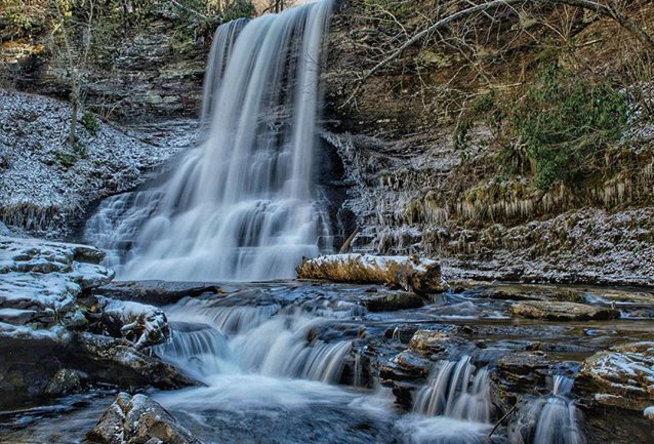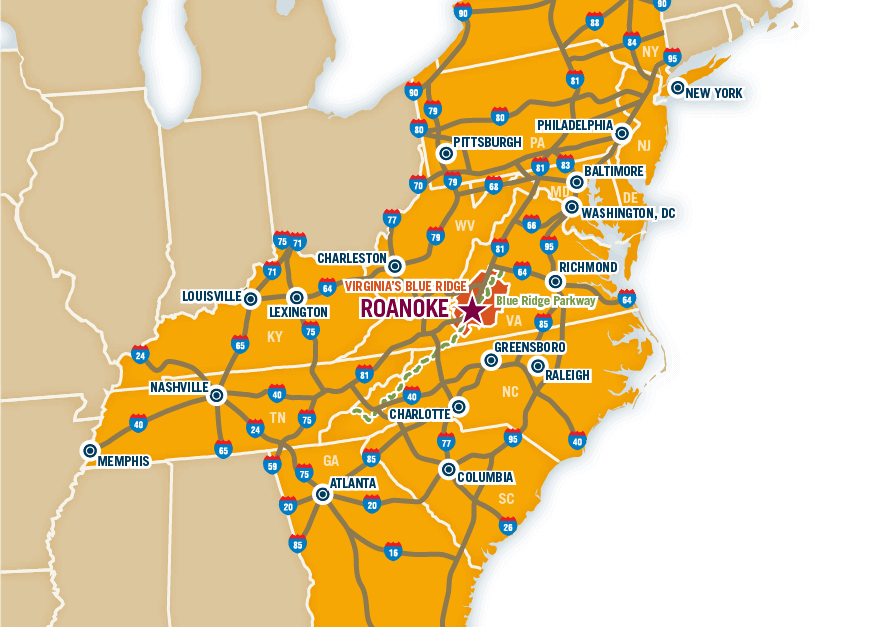You heard Punxsutawney Phil, we’re in store for an early spring! And because we see no reason to doubt that adorable marmot, it’s best to start planning snow melt hikes now.
As winter fades and the snow that’s covered some of our best trails melts away, the saturated ground and spring showers tend to have a dramatic effect on the already breathtaking waterfalls in Virginia’s Blue Ridge.
Whether you're hiking to a waterway or waterfall, snow melt and spring rains ensure the payoff for these seven hikes will be worthy of your finest hiking selfie. (Don’t forget to tag #BlueRidgeDay)
1. Apple Orchard Falls
Contrary to the name, you will not be tromping through an Apple Orchard. In fact, the name simply refers to the colors of the dominant northern red oaks that line the trail. However, true to the name, this hike will lead you to a 200 foot waterfall, one of Virginia’s tallest and most spectacular. Closely following picturesque mountain streams for nearly the entire 7.5 mile loop, Apple Orchard Falls is a moderately difficult trail, perfect for an invigorating day hike.
Located east of Buchanan in the Jefferson National Forest, the commonly preferred blue blazed Apple Orchard Falls trailhead is accessed from the end of Forest Road 59 off of Route 614. Once you reach the waterfall, enjoy the crash of the water flowing down the 200’ boulder face from the wooden purpose built deck and benches, constructed by the Forest Service in 2000.
2. Bottom Creek Gorge
Not to be outdone, trails found at Bottom Creek Gorge feature views of the second tallest waterfall in Virginia. Located in Montgomery County, Bottom Creek is a powerful mountain stream that forms a stair-step series of broad-basin waterfalls known as "The Kettles." Flanking Bottom Creek are forests of mixed hardwoods (tulip poplar, maple, oak, hickory) and upland meadows. Among the 1,657 acres, hikers will walk among virgin hemlocks and hundreds of wildflowers.
It should be noted that the gorge is protected by The Nature Conservancy, due to the location being identified as a hotbed for rare aquatic species. Bottom creek is home to rare fish like the orangefin madtom, and the bigeye jumprock, while a half-acre of shale barren provides habitat for the globally rare chestnut lipfern. The protected land is open to the public to enjoy, but hikers must leave their four legged friends at home, as there are no dogs allowed.
3. Tinker Ridge & Hay Rock Overlook
This eight mile out-and-back hike offers plenty of payoff, as views of Carvins Cove Natural Reserve sprawl below you from the top of the ridgeline at Hay Rock Overlook. Of course, you have to get their first! Tinker Ridge Trail crosses Tinker Creek, the site depicted in Annie Dillard’s 1974 book, Pilgrim at Tinker Creek, before ascending Tinker Ridge to the Hay Rock Overlook.
The Tinker Ridge hike can be enjoyed in any season, but in March as the days warm and spring showers fill the Cove’s 630-acre reservoir, water levels at capacity truly display the size and scope of the second-largest municipally owned and managed park in the United States.
4. Carvins Cove
Once you’ve seen Carvins Cove from the Hay Rock Overlook, you’ll undoubtedly be drawn down the road to check out the more than 40 miles of multi-use trails that weave through the 12,700 acre nature reserve up close. While the Cove’s reputation as an east coast mountain biking destination not to be missed is well deserved, those same trails offer challenging upper trails and relaxing lower trails for hikers of all abilities.
Located only six miles from exit 141 off of Interstate 81, the scenic drive to the Bennett Springs parking lot will give you a clear idea of the views you have in store. From the parking lot, you can choose to tackle the upper or lower Carvins Cove trails. During the rainy season, we recommend going up, but with 40 miles of trails well maintained by volunteer driven groups like Pathfinders for Greenways, the Roanoke Chapter of IMBA and others, you can build the perfect hiking route that suits you best in any weather.
5. Cascade Falls
An estimated 150,000 visitors a year enjoy the Cascades and if you are lucky enough to time your hike to the popular falls towards the transition between winter and spring, you may very well enjoy a raging torrent of water crashing over the 69 foot waterfall framed by ice formations clinging to the 200 foot cliff walls. The Cascades National Scenic Trail following Big Stoney Creek upstream eventually forks into an upper and lower trail. If you are able, the lower is our suggestion.
Closely hugging the Little Stony stream, rushing water will be your soundtrack as you continue down the lower trails towards Cascade Falls. You’ll know you are getting close when the upper and lower trails meet again, and just beyond some heavy vegetation and one enormous boulder Cascade Falls will suddenly reveal itself. This four mile roundtrip hike may not be as demanding as some of the trails found in Virginia’s Blue Ridge, but it is certainly one of the most popular and most photographed.
*Insider’s Tip: If you’ve had enough hiking for one day, the Upper Trails offer you the best opportunity for a quick, direct route back to the parking area.
6. Roaring Run
As if the name of the hike wasn’t intriguing enough to demand a trip to Eagle Rock, five footbridge crossings leading to the stunning Roaring Run Falls ought to be. Roaring Run is the perfect opportunity for a hike with the entire family. Considered a simple out-and-back hike, the well-marked trail begins at the Roaring Run Furnace, a 19th century iron ore furnace that was used for a variety of purposes in the pre-Civil War era and is on the National Register of Historic Places.
While the falls impress, don’t miss the natural water slide approximately half way into the short hike. Of course, the slide is dependent on the level of the Roaring Run stream. If water levels are up, the same area offers Class V rapids for thrill seeking kayakers. Complete with toilets and a picnic area with a charcoal grill, Roaring Run is truly a family-friendly hike.
7. Waid Recreation Park
Franklin County’s Waid Recreation Area is a 500-acre park located near the Town of Rocky Mount along the site of the Old Carolina Wagon Trail, which dates back to the late 18th century. The park offers a variety of outdoor activities for all ages and features river access throughout. In addition to playgrounds, sports fields, fishing, and canoeing, the recreation area features 7 miles of walking and hiking trails that wind through the park, crisscrossing Pigg River, a tributary of the Roanoke River.
*Insider's Tip: Pigg River is a fantastic Class I waterway for a relaxing four hour float!
Looking for more opportunities to go hiking? Visit our Hiking page for information about the hundreds of miles of trails in Virginia's Blue Ridge and check out our list of 10 Great Hiking Trails. You can also click here to sign up for our monthly e-newsletter!












